I have always found the mechanical alarm to be an underappreciated, and certainly underutilized, complication in today’s luxury watch field. (Check out some of my favorites in the category here.) When I recently discovered that Cyrus — an innovative indie brand named for the historical Persian ruler Cyrus the Great — had not only made an alarm complication, but one that incorporates the chiming functionality of a minute repeater for a fraction of what a repeater would cost, I was anxious to give it a test drive. Scroll down to discover how this very distinctive timepiece performed during a week on the wrist.
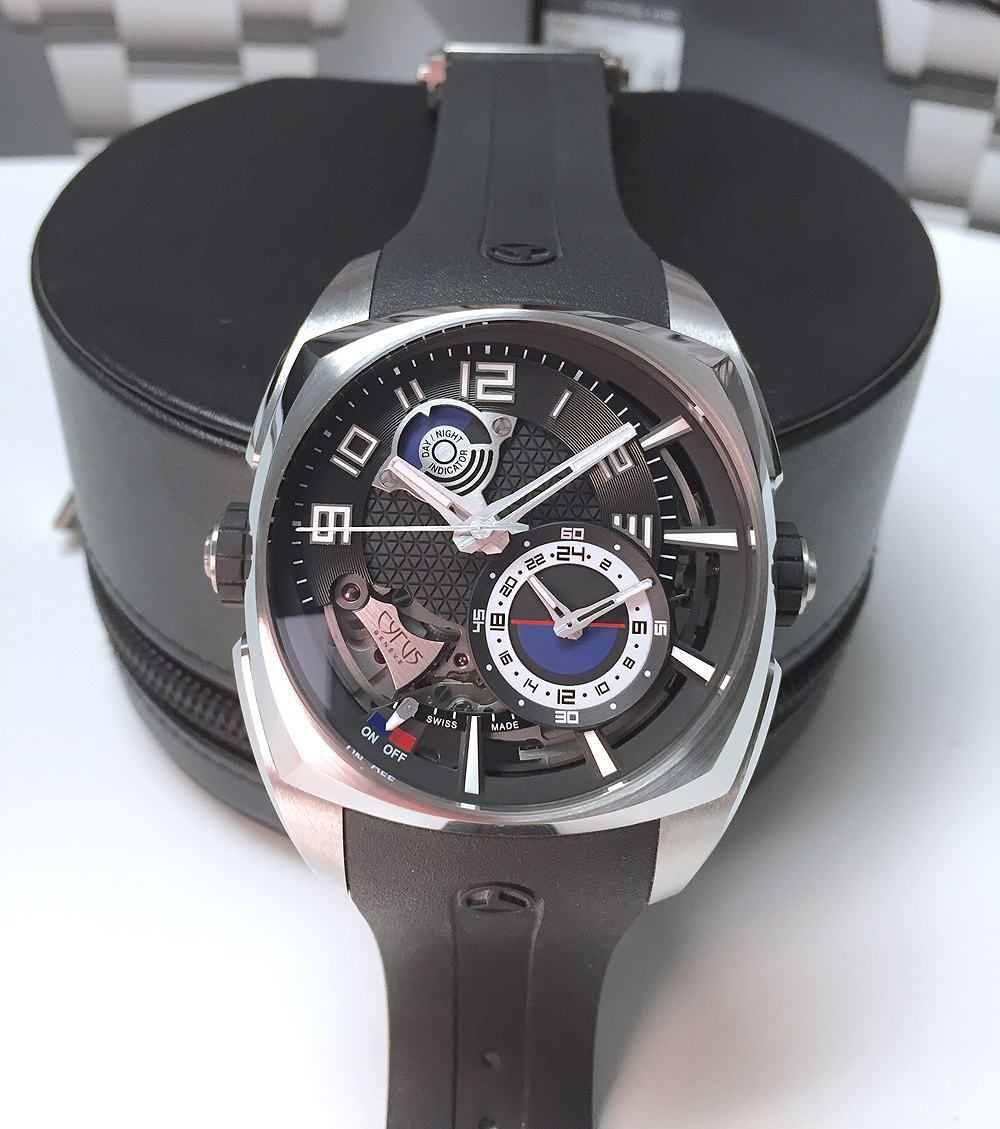
The first thing you’ll probably notice about the Cyrus Klepcys Réveil is its unusual and large case, with a multilayered cushion shape framing a wide, round dial opening. Combining a titanium caseband with stainless steel lugs, bezel, and screw-down caseback, it measures 46 mm in diameter, most surfaces are brushed, while the bevels are polished.
The second would be the slightly off-center look of the dial itself, with blocky applied Arabic numerals at the 1, 2, and 3 o’clock hours (actually the “3” numeral is cut off by the alarm subdial), after which the numerals give way to unusually shaped, diamond-polished hour indices (these actually begin appearing alongside the “2” and “3” numerals), which terminate at 6 o’clock to make way for other visual elements between 6 and 9 o’clock. The Arabic numerals — all of which appear on a semicircular, black, grooved track that brings to mind an old phonograph record — then pick up again at 9, 10, 11, and 12 o’clock. The rest of the dial is a cornucopia of elements that should be touched upon in detail.

First, there is the large subdial situated between and 3 and 5 o’clock upon which the alarm function is set. It has two concentric rings: a black outer scale for the minutes, with white numerals at each 15-minute quadrant, and a white inner ring with black, even numerals representing 24 hours. Inside the white hour track, the subdial is black in its top half and dark blue in its bottom sector, divided by a thin red line. Two small, openworked hands indicate the hours (on a 24-hour scale) and minutes.
Dominating the dial space between 9 o’clock and 5 o’clock is a large, asymetrically cut aperture which offers a glimpse into the watch’s movement, with the spotlight clearly focused on the little chiming hammer, with brushed finish and engraved Cyrus logo, that visibly strikes its gong when the pre-set alarm time is reached on the main dial. An engraved criss-cross pattern embellishes the upper half of the dial and a larger pair of hands —also openworked, with Super-LumiNova tips, and placed on an off-center axis — indicate the hours and minutes, while a thin sweep-seconds hand on the same axis orbits the dial. At 11 o’clock, a round day-night indicator is fastened to the dial by two tiny screws whose heads feature the propellor-like Cyrus logo.
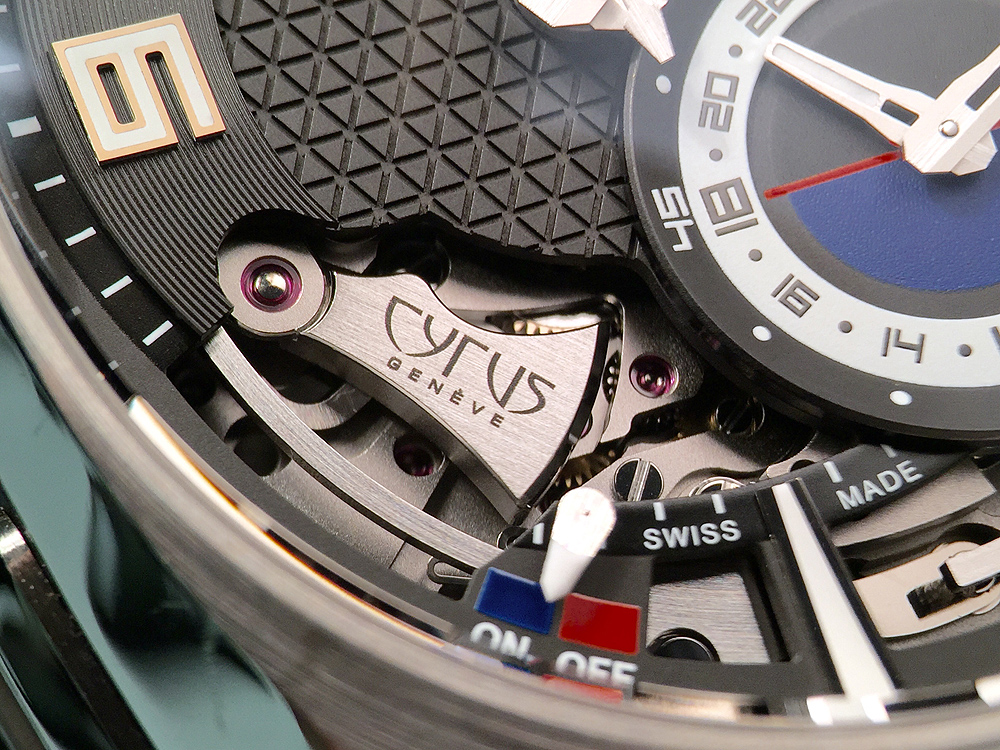
The operation of the alarm function is simple and intuitive. First, set the time on the main dial by pulling the right-hand crown to its second position. There is no date indication on the watch, but the helpful day-night indicator at 11 o’clock makes it relatively easy to know whether the hours and minutes are set to AM or PM hours; the blue field indicates daylight hours and the black field, nighttime hours. Personally, I would have chosen a blue that was not quite so dark and close in tone to the black; in dim light it can be a bit difficult to discern day from night. Maybe even going with a white instead of blue would’ve been less a literal translation of the sky but more a stark, easy-to-read contrast. In any case, this display both adds to the watch’s unusual look and facilitates the use of its signature complication.
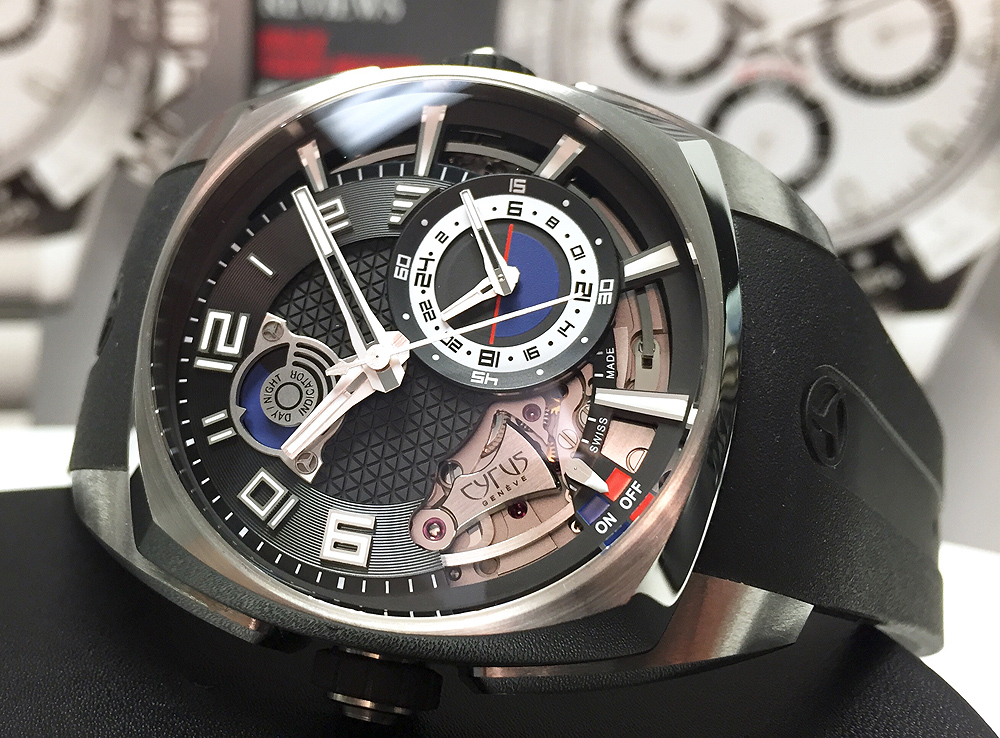
To set the alarm, push the crown gingerly back to its first pulled position, which rotates the hour and minute hands in either direction on the 24-hour scale. Again, very intuitive and user-friendly: for example, if the hour hand is pointing at 14 (in the daytime sector) and the hour hand is pointing at 60 (nighttime sector), your alarm is set for 2:00 PM. If the hour hand is at 4 (nighttime sector) and minute hand at 30 (daytime sector), your alarm is set for 4:30 AM. Also helpful for sticklers, the alarm can be set in five-minute increments. To set the alarm from ON to OFF, push the crown back in and push the button in the center, which toggles the little white arrow pointer from the blue ON sector to the red OFF sector, located right around the 7 o’clock mark on the dial. Be careful, though; it’s rather sensitive, so it’s easy to inadvertently switch the alarm off or on simply by pushing in the crown too forcefully. In a nice, subtle touch, the ON/OFF pointer is also Super-LumiNova-tipped, just in case you need to check during the wee hours whether or not the alarm is set.
Incidentally, by now you’ve probably noticed the other very unconventional aspect of this watch’s design, the dual crowns on each side of the case, which is in fact a defining aesthetic trait of the Cyrus collection. In most models, each of the two crowns is functional, but in the case of the Klepcys Réveil, the 9 o’clock crown is purely aesthetic, despite the fact that the grooved rubber grip around the crown unscrews. It does serve something of a purpose, though, as it is emblazoned with the watch’s serial number.
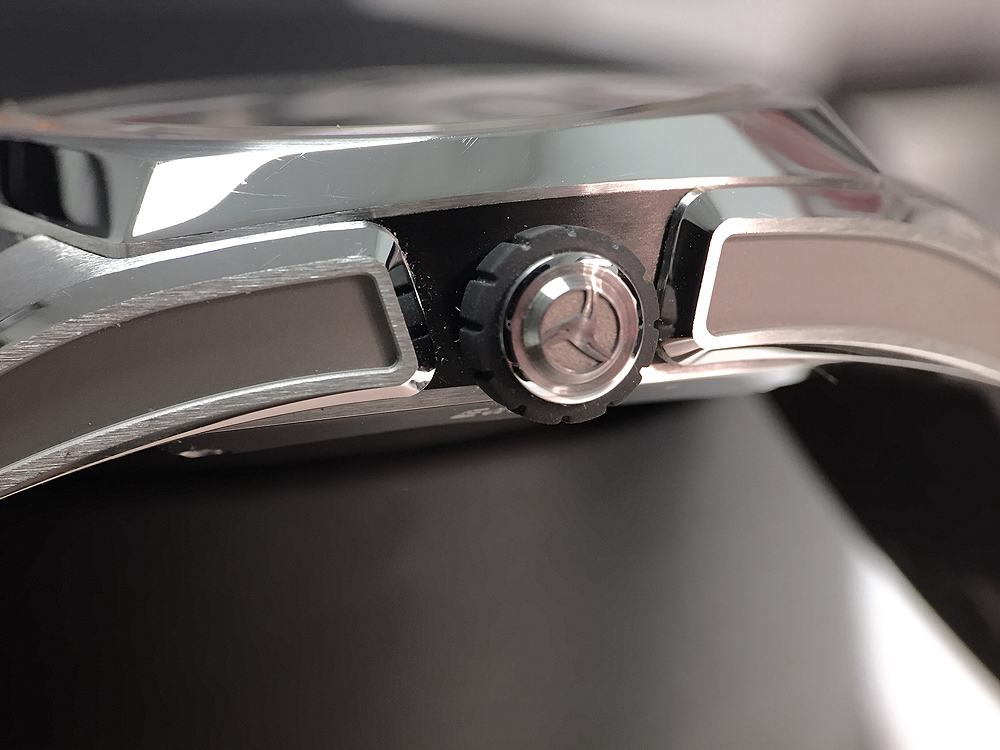
The alarm’s chimes, which sounded faithfully on the dot each time I set them, have a pleasant, jangling cadence, loud enough to be heard but soft enough not to disturb a room. Just push the crown button to “off” when you want to silence the chimes; otherwise, they will automatically halt after 16 seconds. Again, this is not as complex a system as a minute repeater or a sonnerie, with hammers and gongs that strike different series of chimes that indicate hours, quarter hours, et cetera, but it sounds a far more elegant alert sound than most mechanical alarm watches, which produce more of a buzzing sound. Think of it like you’re waking up to distant church bells or birdsong rather than the high-pitched beeps of your nightstand alarm clock.
The movement, as with several others in Cyrus’s portfolio of complicated watches, is a product of the brand’s frequent collaboration with Jean-Francois Mojon, leader of the Swiss movement-making atelier Chronode. (Not coincidentally, Chronode and Cyrus have the same owners, and another of Chronode’s clients is Hublot, whose Big Bang Alarm Repeater is the only other watch I’m aware of to boast this type of mechanical alarm function.) Dubbed Caliber CYR1280, this manually wound movement is visible through the watch’s wide sapphire window in the caseback.
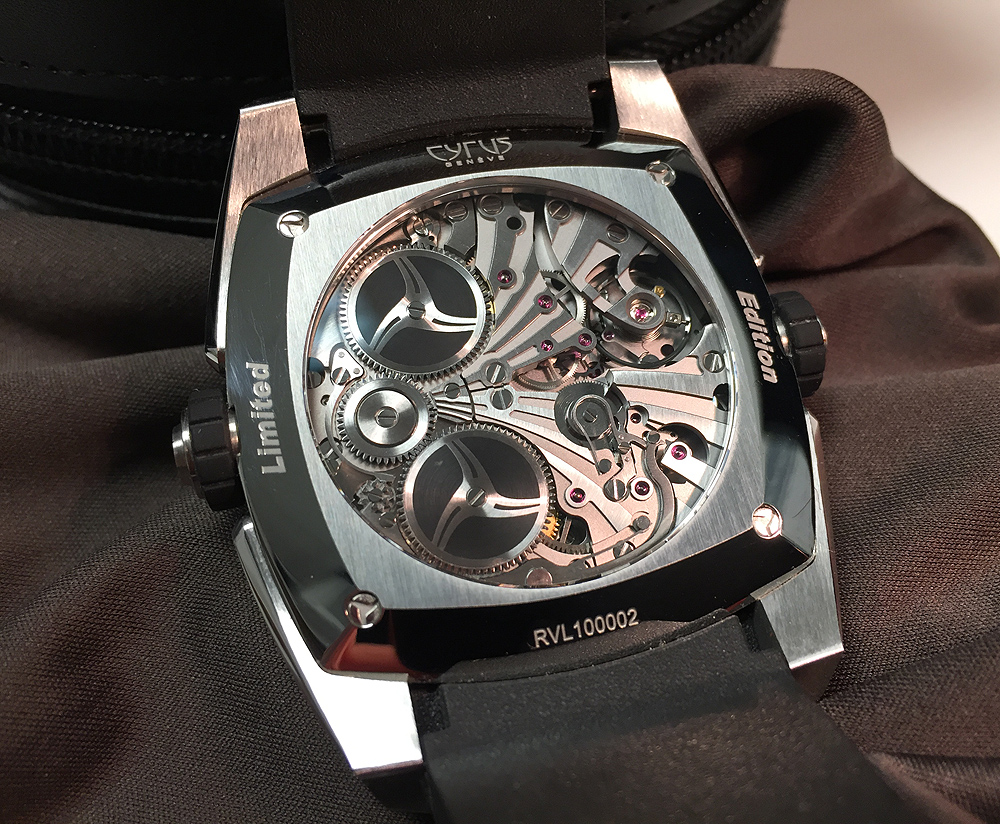
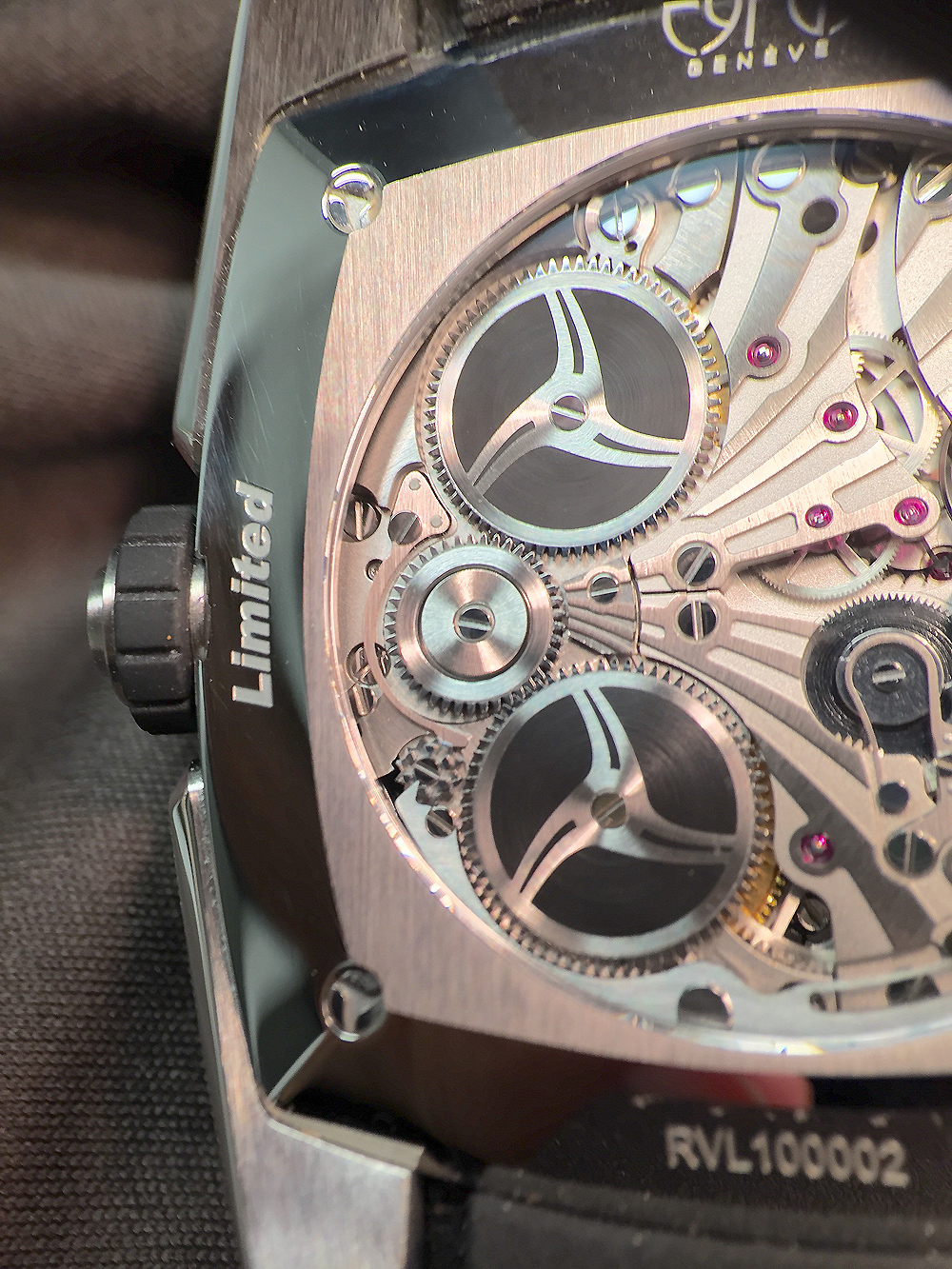
Immediately in evidence are the two separate barrels, which store the spring for both the timekeeping and the alarm. Cyrus’s watchmakers designed the winding system so that the spring inside the mainspring barrel slips when it has amassed its maximum power reserve of 72 hours, enabling the wearer to continue turning the crown, to fuel up the alarm function, without damaging the mainspring. I’ll confess that it was difficult to determine exactly how many turns were needed to fully wind the movement and alarm, and the watch did stop unexpectedly once or twice when I wasn’t giving it a regular morning winding. (Some type of power-reserve display might well have been one element too many on the crowded dial, but it would have nevertheless been helpful in this regard.)
The barrels, like the crowns and the screws that fasten the caseback, feature the Cyrus logo, and the mainplate and bridges are enhanced with a series of engraved, radiating grooves that echo those in the curved caseband. Dotting this micromechanical landscape are no less than 50 jewels. The balance oscillates at 4 Hz. And the use of a manual winding system means that no rotor obscures any of these finely finished components at any time.
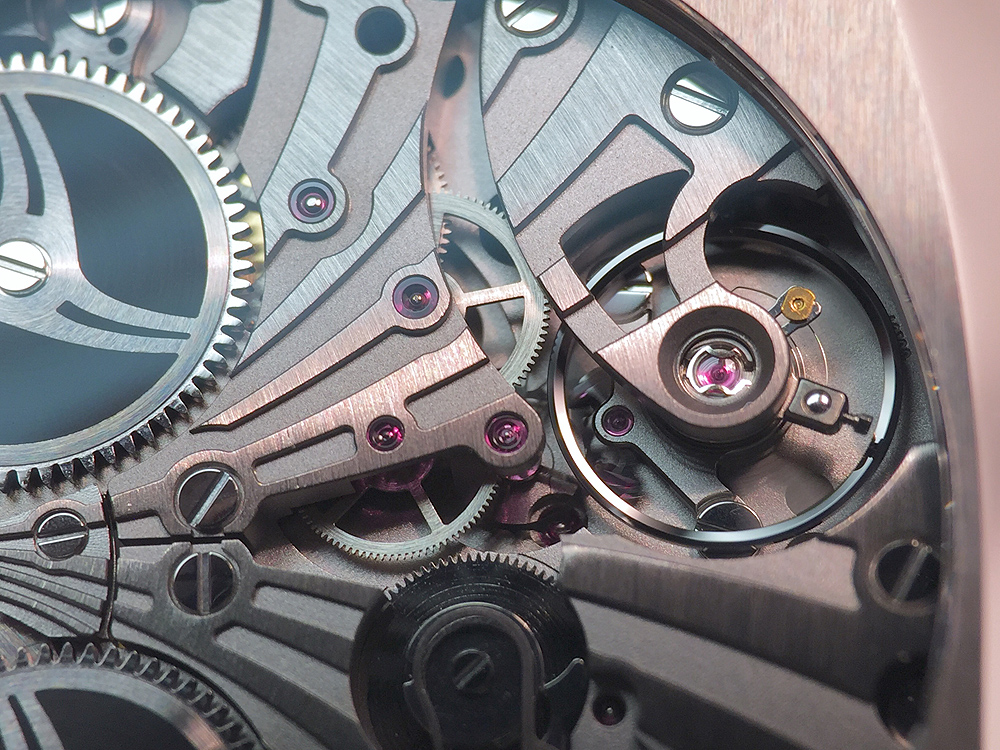
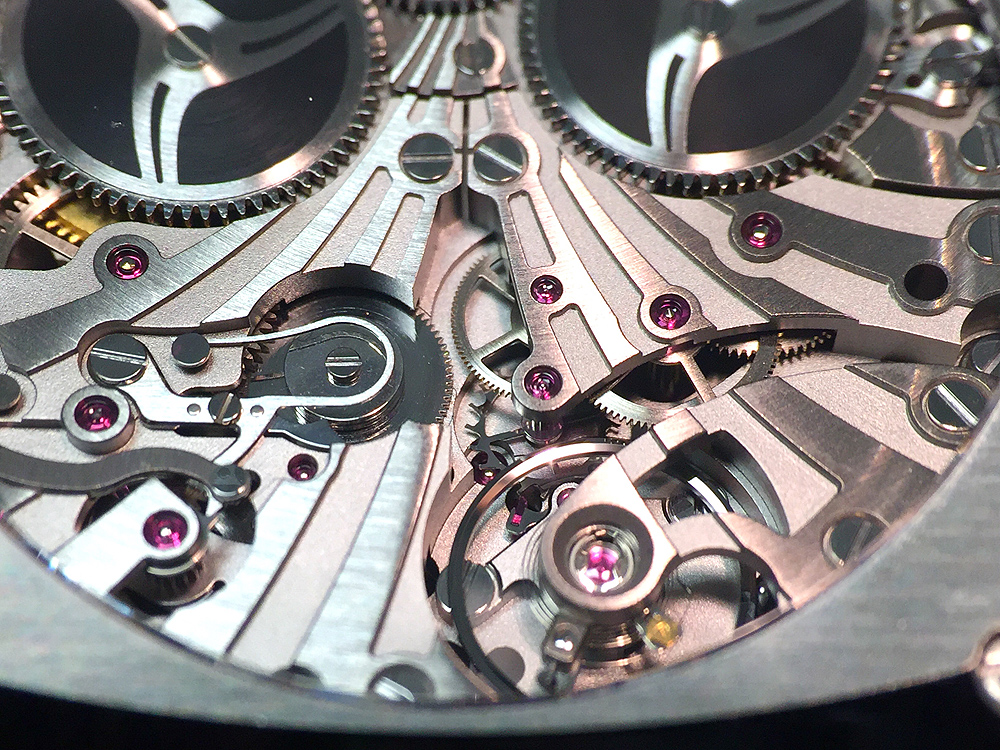
The black, textured rubber strap, while it doesn’t necessarily scream “luxury,” is nevertheless the perfect fit for this very avant-garde timepiece, sporting embossed Cyrus logos on each end closest the case and a sunken middle section that (again) echoes the grooves on the movement plate and case middle. It integrates seamlessly into the lugs and fastens with a two-bladed folding clasp with a comfort-adjustment device and titanium cover. And while this watch certainly is large on the wrist, it is not overly weighty. Furthermore, its very distinctive design will make it a conversation piece whether you’re working a room full of watch aficionados or just chatting with co-workers at your local watering hole. Unlike, say, tourbillons, or chronographs, or complicated calendars, the humble alarm complication is one that is usually rather subtle until it actually starts making noise. The Cyrus Klepcys Réveil, by contrast, announces its presence even when it is embracing the sound of silence.
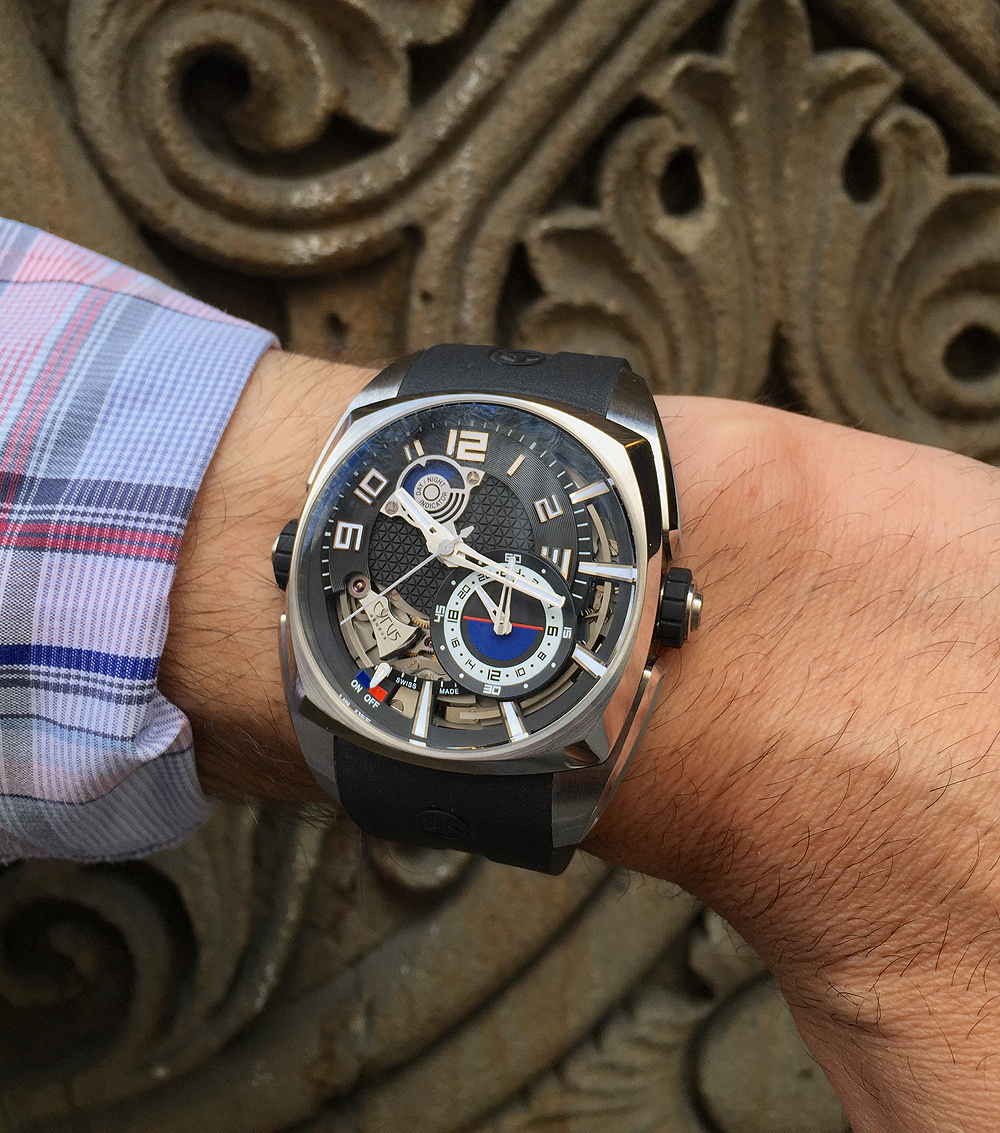
The Cyrus Klepcys Reveil in steel and titanium (Ref. 539.502.SS), which I wore for this review, costs $39,000 and is limited to just 10 pieces. Other case versions are available in steel and black DLC ($39,500), and all-black-DLC-coated steel ($39,900), each also limited to 10 pieces, for a total of 30 watches in the collection.

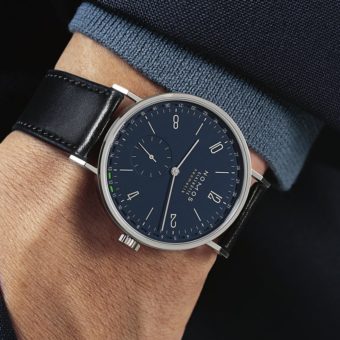





Perfectly sized case and intriguing dial! I’d love to hear the alarm. The watch appeals to almost all the senses. Now if they had incorporated a Pez dispenser into the case and put a scratch and sniff under the strap somewhere…